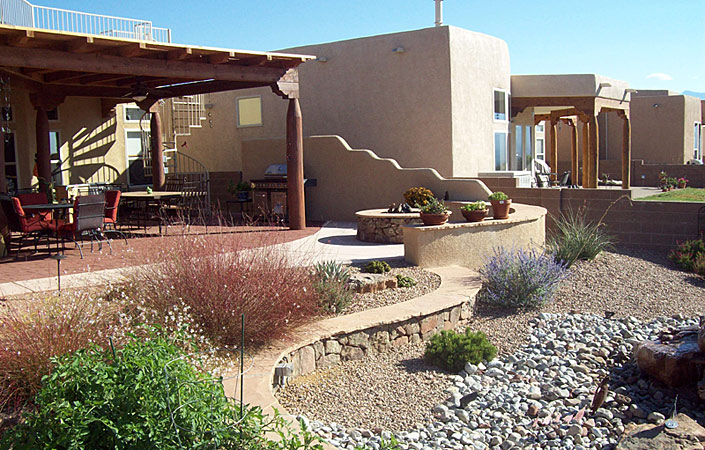Seven elements of xeriscaping for less water, less maintenance

There is no such thing as a NO maintenance yard, but xeriscaping your yard can reduce the amount of work you put into it. Not only does a xeriscape require less maintenance, but you will reduce your water bill and the cost of fertilizers and pest control normally associated with a water-loving lawn.
Besides those benefits, if you live in Albuquerque, the City of Albuquerque offers a rebate for people who convert their thirsty landscapes to xeriscape! Here are some tips to help you get started.
- Work the plan, plan the work
Have a plan. Take a look at your yard’s layout. Is it hilly or flat? Is it sunny or shady? Rich soil? Create planting zones and group your plants by their needs. For example, group tough, drought-tolerant plants in areas exposed to full day sun, give tender plants some partial shade and keep the more delicate or demanding plants for a spot near your water source. If you’re not sure how to start, our design team can help you. - Put the right plant in the right spot
You may choose to incorporate a few plants that will need to be coddled, but for the most part, selecting plants that thrive in your area during low water conditions will give you the best results. This includes native species that we so often take for granted. You might be surprised to see how many plants are considered xeric once they have established themselves and are properly cared for. Look at our resources page for some ideas. - Improve soil to support xeriscape
While many xeric plants do well in native soils, it is not a bad idea to improve the soil. The trick is to incorporate generous amounts of organic matter. This will improve water penetration and retention in any type of soil. Rich, loose, water-holding soil will encourage good root development and lessen the plant’s need for supplemental water. It is best to amend your soil before planting. - Mulches hold moisture and aid in weed control
Organic mulch moderates soil temperature, holds moisture, slows erosion and suppresses weeds that would compete with your plants for food and water. It also gradually decomposes and feeds the soil. Gravel mulch helps in much the same way except it doesn’t add organic matter to the soil. Gravel doesn’t have to be replaced as often and can be used in beds that need to look tidy all the time. - What about a lawn?
There are benefits from having a lawn, but many of us have way too much lawn. How much water, fertilizer and gasoline does it takes to keep your lawn green throughout the summer? What is the purpose of the grass? Is it part of your outdoor living space? A place that family and pets can enjoy? If the answer is yes, then by all means include a lawn in your yard. If you are using grass only as a ground cover, there are other options that would be less labor and water intensive. This is especially true for front yards. - Water efficiently
Not every plant needs the same amount of water. We recommend an automatic drip irrigation system for watering. You can control when and how much water a plant gets and direct the water only to the plants that need it. But don’t just “set it and forget it.” Make seasonal adjustments. Plants will require more watering for the first year or two as they become established, so keep an eye on new plantings. However, after they have acclimated and developed a good root system, supplemental watering should be less frequent. - Maintenance is still part of the equation; but less than with a “normal” landscape
Yes, even a xeriscape yard will require some maintenance. Watering, weeding, pruning, deadheading and sensible pest management is part of your overall maintenance program to keep your landscape looking good.
Xeriscapes do not have to be boring expanses of gravel. By using the right combination of plants, trees and accents you can have a lush looking yard and still feel good about saving money and our precious resources. Contact us if you’re interested in turning your into a xeriscape garden.


